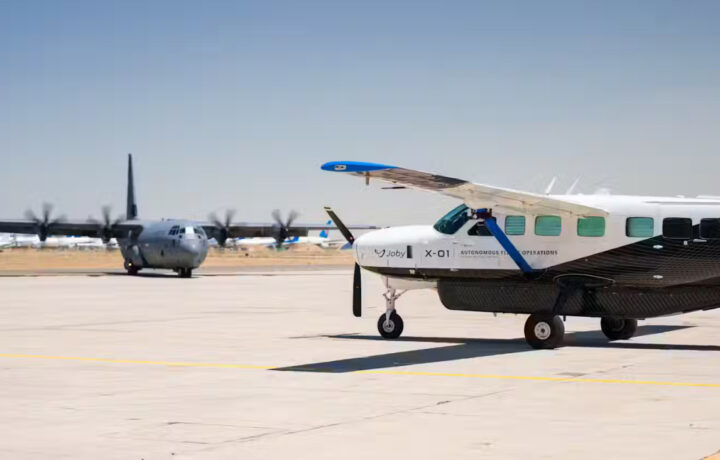The Cessna 208 Caravan is noted for being an adaptable utility aircraft that can be employed for flight training and transporting air cargo and passengers. Though most of the planes are in civilian service, the U.S. military operates a number of aircraft, which serve in various roles.
One of those Caravans served as a test bed for self-flying aircraft and flew more than 3,900 miles (6,276 km) during a recent Agile Flag military exercise in California and Nevada.
The 23rd Wing from Moody Air Force Base (AFB), GA, and the 9th Reconnaissance Wing from Beale AFB, CA, oversaw the flight test of the autonomous aircraft. The wings used Joby and Reliable Robotics’ autonomous flight technology, which enabled the Cessna 208B Grand Caravan aircraft to taxi, take off, fly to a destination, and land independently where it delivered cargo including aircraft parts and supplies.
Joby and Reliable Robotics are partners in the Autonomy Prime program with the Prime division of AFWERX, an Air Force Research Laboratory (AFRL) directorate. It is now partnering with the private sector to accelerate testing and affordably deliver game-changing technology to the warfighter – and the companies have each been awarded Small Business Innovation Research Phase Two and Phase Three contracts to conduct autonomous flight trials and demonstrate the capability in an operationally relevant environment.
“AFWERX operates with a certain level of risk, as we often move forward before hard requirements are established — similar to how venture capitalists act before the market fully forms, hoping to find the next big thing,” said Ian Clowes of AFWERX Prime stakeholder engagement. “Our goal is to grow the defense industrial base through small and medium-sized companies.”
Cessna Caravan Controlled Via a Laptop
While a human was still in the cockpit of the Cessna 208B as a “safety pilot,” the aircraft conducted all the flight operations. The aircraft traveled to nine different locations, including multiple airstrips it had not previously visited. In addition to the human in the plane, Joby monitored the flight via a laptop and satellite communication terminal – which combined can fit in a backpack.
“We were pleased to continue demonstrating the capabilities of our autonomy technology during Agile Flag 24-3, where we completed dozens of fully autonomous aerial missions and showcased an ability to perform rapid resupply,” said Maxime Gariel, autonomy lead at Joby. “We look forward to continuing to work with the U.S. Air Force as we further develop the suite of technologies that could enable greater automation or full autonomy, first on the Caravan and then on numerous other aircraft types.”
Earlier this year, Joby acquired autonomous flight pioneer Xwing, which had flown its autonomous Cessna Caravan aircraft more than 300 times since 2020. It was also in April 2023 that Xwing initiated the FAA certification process for the autonomous Caravan, making it the first standard-category large uncrewed aircraft system (UAS) to receive official project designation from the agency, AINOnline reported.
Autonomy Prime is a technology program within the Prime division of AFWERX, a directorate of the Air Force Research Laboratory. The program partners with the private sector to accelerate testing and affordably deliver game-changing technology to the warfighter.
AFWERX has awarded both Joby and Reliable Robotics Small Business Innovation Research Phase Two and Phase Three contracts to conduct autonomous flight trials and demonstrate the capability in an operationally relevant environment.
Moving Cargo Via Smaller Aircraft
According to the Air Force Material Command, the Grand Caravan was able to fly roughly 1,150 miles with 1,200 pounds of cargo. It also highlighted how small commercial aircraft could free up larger cargo planes.
“Previously, we faced a tough choice: either use a cargo aircraft with all the associated expenses or forgo the flight altogether, which created difficult decisions for warfighting commanders,” said Col. Max Bremer, Air Mobility Command Special Access Program management officer. “The return on investment with this technology is significant. By using it to handle smaller cargo, we can preserve cargo aircraft for more critical tasks like transporting large parts, engines, or weapons. This not only enhances the overall capability of the cargo fleet but also ensures they are used where they are most needed.”
The command further addressed the fact that Cessna aircraft are far more affordable to operate than traditional Air Force cargo planes. It cited a Fiscal Year 2023 (FY23) Pentagon cost report that found that the operating cost per hour for a C-130J Hercules is $7,671, and the operating cost per hour for a C-17A Globemaster III is $20,941 per hour. Those figures included direct expenses including fuel, maintenance, and crew costs, but stressed that the actual costs can vary based on specific mission requirements as well as operational conditions.
By contrast, an autonomous Cessna 208B Grand Caravan was found to have an operating cost of $1,200 to $1,600 depending on the utilization, as well as the type of cargo carried.
“These aircraft are saving the Air Force time and money by getting assets where they need to be in a shorter amount of time,” said Staff Sgt. Miguel Sarmiento, 633d Logistics Readiness Squadron aircraft parts store supervisor. “Looking ahead, if the Air Force adopts autonomous aircraft for asset transport in forward locations, it will increase sorties and flying hours by reducing delays in aircraft maintenance.”
Unmanned Flight
AFWERX’s Autonomy Prime program is just one of several initiatives to explore how self-flying aircraft could be employed by the U.S. military – in part to reduce costs, but also to address the ongoing pilot shortage.
In December 2022, a highly modified F-16 – known as the X-62A or VISTA (Variable In-Flight Simulator Test Aircraft) – successfully flew for more than 17 hours at the Air Force Test Pilot School (TPS) at Edwards AFB, CA. Throughout multiple flights conducted over several days, the tests demonstrated how AI agents can control a full-scale fighter jet.
The development of autonomous aircraft will continue to be a priority for the U.S. Air Force.



